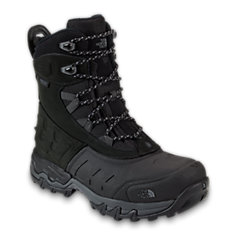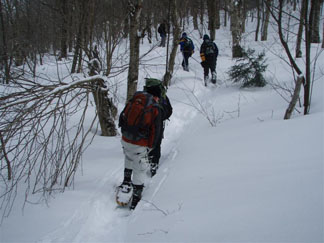
learn
Winter Hiking 101
By Mike Boisvert.
Ever talk to someone who has never gone winter hiking? Many of them will say the same thing: "Brrr! Why would I want to spend all day outside in the cold?" They don't know about all the cool things we do to stay warm. Most people don't know how warm the sunshine feels or how toasty you can get when you're hiking on a perfect winter's day. Read more to learn about the basics of winter hiking.
Winter hiking is different than summer. It's darker, colder, and it can be rougher on your body. Staying warm without getting too hot can be a tricky dance. Here is what you need to know:
THINK IN LAYERS
(1).jpg)
The key for winter hiking is layers, especially for new hikers (or those who are new to hiking outside in winter). Too hot? Just take a layer off.
I recommend the three-layer system.
The first or base layer should be made of a synthetic fiber, merino wool or a synthetic/merino wool blend (the higher percentage of merino wool, the more expensive the item tends to be); long sleeved top and bottom. Just avoid cotton, especially right next to your skin. It will be soaking wet and twice its original size after you sweat.
The second layer should be the insulating layer, something that keeps heat close to your body. This one varies depending on the temps and just what you're doing but you will want at least one layer of fleece and perhaps more. For those times that I'm at rest, or for an emergency I also carry mid weight down sweater if I'm going to be out for long, am going very far, or if I'm venturing above the treeline.
And the third layer is a shell that protects you from wind, rain or snow, if necessary. In winter this will be worn much more for it's wind shedding qualities than for it's waterproofness. Especially if venturing above treeline, as it's there that you'll find that the wind is seldom still in the winter!
.jpg)
What is cool, cold and really cold will depend on your body and the over all weather picture. You have to take both wind and humidity into account when planning what to wear. I recommend having clothing for 10 to 20 degrees colder than it is outside your home because temperatures will be colder higher up and also windier.
That said, you should actually be dressing for 10 to 20 degrees warmer than it is outside because you will heat up once you get started. I often think if I’m not a little bit cold in the beginning of my hike, I’m overdressed.
You can also start hiking and then after 10 minutes start shedding off a layer and putting it in your pack.
DON'T FORGET THE ACCESSORIES
For your head, you can wear a fleece/wool hat or a band that covers your ears. And, for those really cold and/or windy times you'll want something like a balaclava. If you don't go the balaclava route than you can use your hat with a simple inexpensive face mask but it is important that you be able to cover every inch of exposed flesh if the temps get too low.

If your fingers are cold, try mittens or mittens over gloves so you can take the mittens off if things warm up. I wear a thin "liner" glove under my mittens so I can avoid ever having to expose bare skin. You should most likely have at least a couple of pairs of thin "liner" gloves, and a pair of good mittens.
On very cold days, I place chemical heat packs [hand warmers] inside my mittens and they work remarkably well to keep my hands warm. I always carry a spare in case they stop loosing heat. They are sold at drug and hardrware stores.

?For shoes, one option is to winter hike in regular summer weight hiking boots. I know that many think this type of boot doesn't provide enough warmth but I know of dozens of others that have used them for winter. Second option is a winter insulated boot which are becoming more and more popular. The amount of thininsulate will tell you how warm they will be; the higher the number the warmer they will be.
.jpg) You can buy winter traction devices that go over your boots for slipper surfaces which are available at any outdoor gear store. You will want something that attaches firmly to whatever boots you will be using in the winter so my suggestion is to use Katoolah Micro Spikes that you see picture here or something a bit more beefier like Hillsound Trail Crampons.
You can buy winter traction devices that go over your boots for slipper surfaces which are available at any outdoor gear store. You will want something that attaches firmly to whatever boots you will be using in the winter so my suggestion is to use Katoolah Micro Spikes that you see picture here or something a bit more beefier like Hillsound Trail Crampons.
The increased amount of winter hikers has resulted with the trails most likely packed down by previous snowshoers so all you need is a winter traction device but there is a growing concern that these are tearing up the trails so everyone should be wearing snowshoes. You definitely will need snowshoes after a fresh snowstorm where you will have to break trail.
For winter hiking on well used trails I recommend you have a plastic, small snow shoe with a built in crampon underneath.
On sunny days I also wear sunglasses because the light reflecting off the white snow can is hard on the eyes. If i'm heading above treeline, I wear goggles to block the winds and potentially blowing snow.
You still need to hydrate hiking in winter. I have tried many different methods and found that for me the most effective is to carry my water in a wide mouth nalgene bottle inside some type of insulation and placed upside down in my pack. They will keep the water from freezing for most of the day as long as the temperature is not too far below zero. I fill up my water bottles with hot [not boiling] water to keep the water from freezing. I also occasionally simply place the water bottle inside a couple of heavy socks. This method does work but does not seem to work quite as well as the insulated parkas do. By placing the bottles upside down in your pack you at least assure that if the water does begin to freeze the ice will be at the bottom of the bottle and thus not hinder you from drinking the remaining water. I've been unimpressed with using a hydration pack for carrying water in winter. Even if you purchased an insulated bladder and the "thermal kit" that covers the tubing and the gulp valve I've found that it will still begin freezing if the temperatures are in the single digits or below. In my opinion the safest, easiest and most effective way to carry drinking water is the good old fashioned way, in the nalgene bottles! This would also be a good place to mention that I like to carry a small thermos with hot cider or hot chocolate. It's amazing how comforting driking hot liquids are on a very cold day.
(1).jpg)
?What you choose to use for a pack will depend of course on what type of hike you'll be doing and on just what you feel you need to carry. Personally I find that for anything other than the shortest of day hikes, my pack needs to be in the 3000 cubic inch range and generally weighs between 20 and 30 pounds with snowshoes attached. An important consideration in picking a pack for winter would be that it have some means to attach your snowshoes when you don't need them on your feet.
It gets dark early in winter so a headlamp to light up the path in front of you may be needed. It's also necessary in the event of an emergency and you end up finishing later than you planned.
If you’re traveling to where you’re going to start your hike (like to a trailhead), make sure you bring something to wear after. You warm up very quickly when you hike but you cool off really quickly when you stop. When the weather does get colder, it’s really important that you have a dry change of clothes with you so you can get out of those wet clothes.
PAL UP TO STAY MOTIVATED
Hiking with a group like GayOutdoors adds accountability and can keep you going. If you don't like hiking in groups, use our 'matchmaking' member database to find someone living near you to be your winter hiking pal. Having an accountability partner can keep you going.
© 2015 Gay Outdoors ; All Rights Reserved.


